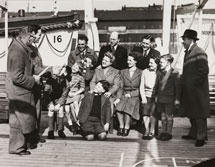|
|

Since the seventeenth century it is estimated that over 17 million
people have left Britain to settle elsewhere in the world. For
much of the post-World War Two period, the number of people leaving
was similar to that of people arriving. Since the 1990s the balance
has shifted so that more people enter than leave the country, but
this imbalance is partly offset by the fact that some of those
leaving are former immigrants returning to their original homes
or moving on to other countries.
Recent figures (2006) showed that in 2004, 222,600 more migrants
came to Britain than left but of these 50 per cent intended to
stay less than two years. The net outflow of British citizens reached
a new high of 235,000 that year, many of these being among the
growing number of retired people buying homes abroad.
In an article in the Financial
Times in August 2006, Dhananjayan Sriskandarajah of the Institute of
Public Policy Research, wrote:
Our borders are being overwhelmed by migration on an unprecedented
scale. Many of these migrants are failing to integrate with their
host communities. Some do not even bother learning the local language.
Local services are struggling to cope with the influx. Worse still,
the UK government seems to know little about the scale or impact
of this migration.
While these may be well-rehearsed descriptions of immigration
into the UK, they may better describe what happens when Britons
move abroad. Emigration from the UK is rocketing but few people
seem to be considering the demographic or economic implications.
Mass emigration from Britain began around 1600 with the settling
of colonies in America and the Caribbean, and the establishment
of trading interests in the East. The majority of the early migrants
were merchants, planters, servants, engineers, field hands, artisans
and administrators. As overseas communities became established,
teachers, doctors and church ministers joined them. From 1615,
criminals sentenced to death received a pardon if they agreed to
be transported to the colonies – a practice which ended in
the mid-nineteenth century. Thousands of children were also sent
overseas under charitable schemes such as the Poor Law Union.
By the mid-seventeenth century, more people were leaving Britain
than arriving, the most popular destination being the West Indies.
At that time, the ‘Ulster plantation’ of six counties
in Northern Ireland was governed as a crown colony and by the end
of the century around 70,000 Welsh and English and 150,000 Scottish
settlers had made their home there.
British emigrants were depicted in the press and popular culture
as gallant torchbearers, in contrast to the people arriving in
Britain who were considered society’s dregs. Author David
Miles describes the situation as follows: ‘if British emigration
(with the exception of prisoners and the Catholic Irish) was seen
as heroic, immigrants were often regarded as pathetic or parasitical.’
The 1803 Passenger Act, ostensibly aimed at raising standards
on emigrant ships, was really designed to put the cost of emigration
beyond the pockets of poor people in response to complaints by
Highland landlords that they were losing too many tenants. However,
by the mid-century, free and assisted passages were being offered
to people with particular skills and trades in recruitment drives
that encouraged emigration to parts of the Empire, particularly
Australia, New Zealand, South Africa and Canada.
Post-World War Two emigration schemes included the incentive of
a £10 fare to Australia. Around a million ‘Ten Pound
Poms’ left Britain at this time, with another million people
moving to Canada. The emigrants were leaving behind a life of austerity,
food rationing and housing shortages for the promise of prosperity
in a country that shared the mother tongue of English and a foundation
in British culture. These emigrants were leaving Britain just as
the Caribbean immigrants, looking for their own new land, were
arriving.
See the BBC’s
Immigration and Emigration website for a clickable
map that provides information on migration to and from the regions
of the UK.
|
|

Emigrating to Australia, 1949 (Science
and Society/NMPFT Daily Herald Archive).
|
|